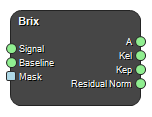Brix
Class: NodeBrix

Calculates pharmacokinetic maps using a modified Brix model with the assumption that signal enhancement is linearly dependent on contrast agent (CA) concentration. The model is given by:
\(\displaystyle \frac{S(t)}{S(0)} = 1+A \frac{kep}{kel-kep} \Big(\exp(-kep\cdot t)-\exp(-kel\cdot t)\Big)\)
in which \(S(t)\) is the dynamic signal and \(S(0)\) is the baseline signal.
Two imputs are required: A baseline signal and a dynamic signal.These must correspond to data acquisition sequences with identical settings(except number of frames). An optional mask can also be provided to limit the calculations to a region.
Produces a pharmacokinetic maps A [arb. unit], kel [min \(^{-1}\)] and kep [min \(^{-1}\)].
Inputs
Signal
The dynamic image.
Type: Image4DFloat, Required, Single
Baseline
The baseline image.
Type: Image4DFloat, Required, Single
Mask
Input mask which defines the region where the calculations will be performed.
Type: Image4DBool, Optional, Single
Outputs
A
Amplitude parameter map.
Type: Image4DFloat
Kel
The elimination constant parameter map.
Type: Image4DFloat
Kep
The exchange rate constant from the EES to plasma.
Type: Image4DFloat
Residual Norm
The residual norm.
Type: Image4DFloat
Settings
Guess A per voxel Boolean
Allow A to be a fitting parameter per voxel (TRUE) or assume a sptially constant A (FALSE).
A Number
Amplitude parameter.
Kel (min¯¹) Number
Contrast elimination rate.
Kep (min¯¹) Number
Contrast extraction rate.
References
- H.T. Ma, J. F. Griffith, D. K. Yeung, and P. C. Leung, “Modified brix model analysis of bone perfusion in subjects of varying bone mineral density,” J. Magn. Reson. Imaging, vol. 31, no. 5, pp. 1169–1175, May 2010
Keywords: Brix, dynamic, contrast, dce, kep, kel
Copyright © 2022, NONPI Medical AB
